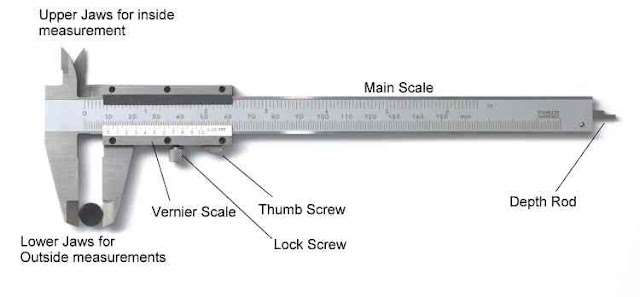Lathe Machine Operations
Lathe Operations:
1.
Facing:
It is
an operation of reducing the length of the workpiece by feeding the
perpendicular to the lathe axis. This operation of reducing a flat surface on
the end of the workpiece. For this operation, regular turning tool or facing
tool may use. The cutting edge of the tool should set to the same height as the
centre of the workpiece.
2.
Turning:
It is
the most common type of operation in all lathe machine operations. Turning is
the operation of removing the excess material from the workpiece to produce a
cylindrical surface to the desired length.
The
job held between the centre or a chuck and rotating at a required speed. The
tool moves in a longitudinal direction to give the feed towards the headstock
with proper depth of cut. The surface finish is very good.
Ø Straight Turning:
The
workpiece is held on the chuck and it is made to rotate about the axis, and the
tool is fed parallel to the lathe axis. The straight turning produces a
cylindrical surface by removing excess metal from the workpiece.
Ø Step Turning:
Step turning means turning a cylindrical workpiece in many step.
Ø Taper Turning:
A
”taper” is the uniform increase or decrease in the diameter of the workpiece
and measured along with its length.Taper turning means to produce a conical
shape by a gradual reduction in diameter from a cylindrical workpiece.The
amount of taper in the workpiece is usually specified on the basis of the
difference in diameter of the taper to its length.
3.
Chamfering
operation:
It is
the operation of getting a bevelled surface at the edge of a cylindrical
workpiece. This operation is completed just in case of bolt ends and shaft
ends. Chamfering helps to avoid damage to the sharp edges and protect the
operation getting hurt during other operations. Chamfering on bolt helps to
screw the nut easily.
4.
Knurling
operation:
It is
an operation of obtaining a diamond shape on the workpiece for the gripping
purpose. This is done to provide a better gripping surface when operated by
hands. It is done using a knurling tool. The tool consists of a set of hardened
steel roller, and it is held rigidly on the toolpost.
Knurling
is completed at rock bottom speed available on a lathe. It is done on the
handles and also in case of ends of gauges. The feed varies from 1 to 2 mm per
revolution. Two or three cuts may be necessary to give the full impression.
5.
Thread
cutting:
It is
the important operation in the lathe to obtain the continuous ”helical grooves”
or ” threads’‘.
When
the threads or helical grooves are formed on the out surface of the workpiece
is called external thread cutting. When the threads or helical grooves are
formed on the inner surface of the workpiece is called internal thread cutting.
The workpiece is rotating between the two centres i.e., live centre and dead
centre os the lathe.
Here
the tool is moved longitudinally to obtain the required type of the thread.
When the tool is moved from right to the left we get the left-hand thread.
Similarly, when the tool is moved from left to the right we get the right-hand
thread.
Here
the motion of the carriage is provided by the lead screw. A pair of change
gears drives the lead screw and by rotating the handle the depth of cut can be
controlled.
6.
Grooving:
It is
the process of reducing the diameter of a workpiece over a very narrow surface.
It is done by a groove tool. A grooving tool is similar to the parting-off
tool. It is often done at the top of a thread or adjacent to a shoulder to go
away alittle margin.
Forming
tools are not supposed to remove much of the material and is used mainly for
finishing formed surfaces. Generally, two sorts of forming tools are used
straight and circular. Straight type is employed for wider surface and
therefore the circular type for narrow surfaces.
7.
Drilling:
Drilling
is that the operation of manufacturing a cylindrical hole during a workpiece.
It is done by a rotating tool, the rotating side of the cutter, known as
drilling drill.In this operation, the workpiece is revolving in a chuck or a
faceplate and the drill is held in the tailstock drill holder or drill chuck.
The
feeding is adopted is affected by the movement of the tailstock spindle. This
method is adopted for the drilling regular shaped workpiece.
8.
Reaming:
Reaming
is the operation of finishing and sizing a hole which has been already drilled or
bored. The tool is used is called the reamer, which has multi-plate cutting
edges.
The
reamer is held on the tailstock spindle, either directly or through a drill
chuck and is held stationary while the work is revolved at a very slow speed.
9.
Boring:
Boring
is the operation of enlarging the hole which is already drilled, punched or
forged. It cannot produce a hole. Boring is analogous to the external turning
operation and may be performed during a lathe. In this operation, the workpiece
is revolved in a chuck or a faceplate and the tools which are fitted to the
tool post is fed into the work.
It
consists of a boring bar having a single-point cutting tool which enlarges the
hole. It also corrects out of roundness of a hole. This method adopted for
boring small-sized works only. The speed of this process is slow.




Comments
Post a Comment